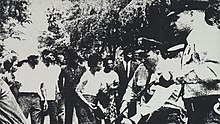|
Race Riot (Warhol)
Race Riot is a 1964 acrylic and silkscreen painting by the American artist Andy Warhol that he executed in 1964. It fetched $62,885,000 at Christie's in New York on 13 May 2014.[1][a] DescriptionIn 1963 Warhol began preparing for a large scale exhibition at the Sonnabend Gallery in Paris. Anxious to avoid a charge of mass-consumerism at his first major exhibition abroad, he chose a theme he initially called Death in America. These paintings, of subjects such as car crashes, suicides, food poisoning, the electric chair, gangster funerals, and the Atom Bomb, were to become known as the Death and Disaster paintings. In an interview at the time, he explained what had made him start:[3][4]
 1963 was also the year of the Birmingham campaign in the Civil Rights Movement. Americans were shocked by a photo-essay published in Life magazine that showed young black protesters being fire-hosed and set upon by police dogs.[5] These Life photographs were by Charles Moore, and the then president John F. Kennedy was to say of them, and of similar images by civil rights photographers of the time, that the events they depicted were "so much more eloquently reported by the news camera than by any number of explanatory words".[6] Three of Moore's photographs were of a dog attacking a black man and although the theme was not strictly "Death", Warhol was sufficiently aware of their power to want to include them in his exhibition, consistent with his aim of showing the dark underside of the American Dream: "My show in Paris is going to be called 'Death in America.' I'll show the electric-chair pictures and the dogs in Birmingham and car wrecks and some suicide pictures."[1][3] In all Warhol made some ten silkscreen painting on the theme. They became known as his Race Riot paintings (counterfactually, in reality the images were of a peaceful march disrupted by police), and they represent Warhol's only overtly political statement, although he himself insisted that Moore's photographs had merely "caught his eye".[1] The first four of these paintings (Pink Race Riot in the Museum Ludwig, Cologne; Mustard Race Riot, in the Museum Brandhorst, Munich; and two other examples whose whereabouts are currently unknown) were made in 1963 in direct response to the Life magazine photo-essay and feature all three of Moore's attack dogs photographs.[7] Pink Race Riot was the painting exhibited at the Sonnabend Gallery in 1964.[8] The remaining six paintings in the series, which Warhol called his "little Race Riots", date from 1964. Of these Race Riot, at nearly six feet square, is the largest and the only multicoloured example. It consists of four panels each depicting the same Charles Moore photograph of a black man fleeing a dog tearing at his trousers, the middle of the three that appeared in Life magazine. The panels are tinted in red, white and blue, possibly refracting the byline Life magazine gave Moore's photographs, They Fight a Fire That Won't Go Out.[b] The panels are a faithful representation of Moore's photograph, but with heightened contrast expressing a newsprint quality. Warhol used Moore's photographs without his permission, and Moore subsequently filed a lawsuit against him for copyright infringement. The case was settled out of court.[10] The painting was originally owned by Sam Wagstaff, who gave it to his partner Robert Mapplethorpe. Wagstaff also commissioned a print from Warhol, Birmingham Race Riot, as part of the series Ten Works by Ten Painters published in an edition of 500 by Wadsworth Athenaeum, Hartford, Connecticut.[11][12] Provenance
Exhibition historyVarious including:
Notes
Citations
Bibliography
External links
|
||||||||||||
